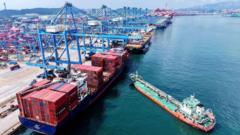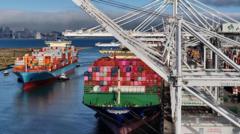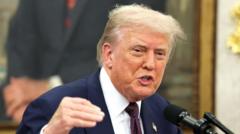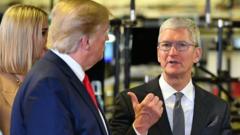With threats of increased tariffs looming, small enterprises like MinkeeBlue are taking proactive measures to mitigate potential economic fallout.
US Businesses Brace for Impact of Potential Trump Tariffs
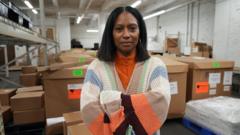
US Businesses Brace for Impact of Potential Trump Tariffs
Firms across America are rapidly adjusting supply chains as Trump hints at new import tariffs.
As the Biden administration faces a barrage of challenges, one of the most pressing issues is the economic anxiety stemming from former President Donald Trump’s renewed tariff threats. Handbag designer Sherrill Mosee of MinkeeBlue, based in Philadelphia, is among many small business owners feeling the urgency of the situation. Initially, Mosee planned to wait on receiving a shipment of 2,700 bags and backpacks from her Chinese suppliers, but the stakes changed dramatically when Trump was re-elected. “I’m like, okay, we’ve got to bring those in,” she admits, highlighting her newfound urgency as firms contemplate the possible ramifications of Trump’s proposed tariffs.
In a recent post on social media, Trump indicated he would enact a 25% tariff on goods from both Canada and Mexico, while imposing an additional 10% levy on imports from China on the first day of his new presidential term. Certain experts suggest that while Trump's trade proposals sound aggressive, they may be more of a bargaining tactic amid broader negotiations concerning various policy issues.
Regardless of the outcome, the mere speculation of increased tariffs has already begun reshaping business strategies. “There’s economic impact, whether it’s bluster or not,” shared Wendy Edelberg, an economist with the Brookings Institution. Companies such as Steve Madden and Stanley Black & Decker are already strategizing how to navigate these potential tariffs, considering relocating their supply chains and adjusting pricing structures.
With business operations uncertain, Edelberg mentioned the potential for increased prices and shortages as firms prepare for possible tariff-induced disruptions. The National Retail Federation (NRF) warned that Trump's tariff initiatives could cost American consumers anywhere between $46 billion and $78 billion annually, affecting the prices of everyday goods significantly — for instance, a $40 toaster might see a price bump to $48-$52.
In terms of manufacturing impacts, Martin Pochtaruk, CEO of Canadian solar panel company Heliene, recounted the challenges his firm faced during previous tariff impositions. Though now operating primarily in the U.S., Pochtaruk expressed concern as materials remain reliant on overseas markets; the anxiety about possible tariffs looms large for many industries.
Furthermore, economists have advised that while tariffs might shield specific sectors, historical evidence suggests an adverse effect on overall employment and consumer prices. Nonetheless, business owners like Mosee are left to navigate uncertainty with limited resources. “It’s going to be hard,” she summarized, expressing the sentiments echoed across small businesses bracing for an unpredictable financial landscape.
In summary, as Trump’s potential tariff policies simmer in the background, firms across various sectors are scrambling to safeguard their futures, making strategic adjustments that reflect a cautious response to significant economic uncertainty.
In a recent post on social media, Trump indicated he would enact a 25% tariff on goods from both Canada and Mexico, while imposing an additional 10% levy on imports from China on the first day of his new presidential term. Certain experts suggest that while Trump's trade proposals sound aggressive, they may be more of a bargaining tactic amid broader negotiations concerning various policy issues.
Regardless of the outcome, the mere speculation of increased tariffs has already begun reshaping business strategies. “There’s economic impact, whether it’s bluster or not,” shared Wendy Edelberg, an economist with the Brookings Institution. Companies such as Steve Madden and Stanley Black & Decker are already strategizing how to navigate these potential tariffs, considering relocating their supply chains and adjusting pricing structures.
With business operations uncertain, Edelberg mentioned the potential for increased prices and shortages as firms prepare for possible tariff-induced disruptions. The National Retail Federation (NRF) warned that Trump's tariff initiatives could cost American consumers anywhere between $46 billion and $78 billion annually, affecting the prices of everyday goods significantly — for instance, a $40 toaster might see a price bump to $48-$52.
In terms of manufacturing impacts, Martin Pochtaruk, CEO of Canadian solar panel company Heliene, recounted the challenges his firm faced during previous tariff impositions. Though now operating primarily in the U.S., Pochtaruk expressed concern as materials remain reliant on overseas markets; the anxiety about possible tariffs looms large for many industries.
Furthermore, economists have advised that while tariffs might shield specific sectors, historical evidence suggests an adverse effect on overall employment and consumer prices. Nonetheless, business owners like Mosee are left to navigate uncertainty with limited resources. “It’s going to be hard,” she summarized, expressing the sentiments echoed across small businesses bracing for an unpredictable financial landscape.
In summary, as Trump’s potential tariff policies simmer in the background, firms across various sectors are scrambling to safeguard their futures, making strategic adjustments that reflect a cautious response to significant economic uncertainty.





